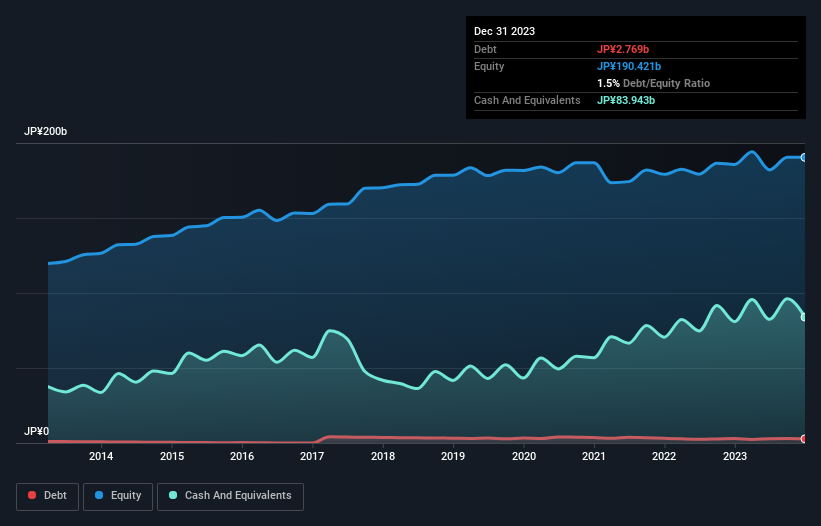
Legendary fund manager Li Lu (who Charlie Munger backed) once said, 'The biggest investment risk is not the volatility of prices, but whether you will suffer a permanent loss of capital.' So it might be obvious that you need to consider debt, when you think about how risky any given stock is, because too much debt can sink a company. We can see that USS Co., Ltd. (TSE:4732) does use debt in its business. But should shareholders be worried about its use of debt?
When Is Debt A Problem?
Debt is a tool to help businesses grow, but if a business is incapable of paying off its lenders, then it exists at their mercy. If things get really bad, the lenders can take control of the business. However, a more common (but still painful) scenario is that it has to raise new equity capital at a low price, thus permanently diluting shareholders. Having said that, the most common situation is where a company manages its debt reasonably well - and to its own advantage. When we think about a company's use of debt, we first look at cash and debt together.
View our latest analysis for USS
How Much Debt Does USS Carry?
As you can see below, USS had JP¥2.77b of debt at December 2023, down from JP¥2.98b a year prior. But on the other hand it also has JP¥83.9b in cash, leading to a JP¥81.2b net cash position.

How Strong Is USS' Balance Sheet?
According to the last reported balance sheet, USS had liabilities of JP¥22.0b due within 12 months, and liabilities of JP¥9.68b due beyond 12 months. Offsetting these obligations, it had cash of JP¥83.9b as well as receivables valued at JP¥6.13b due within 12 months. So it can boast JP¥58.4b more liquid assets than total liabilities.
This short term liquidity is a sign that USS could probably pay off its debt with ease, as its balance sheet is far from stretched. Succinctly put, USS boasts net cash, so it's fair to say it does not have a heavy debt load!
Also good is that USS grew its EBIT at 11% over the last year, further increasing its ability to manage debt. When analysing debt levels, the balance sheet is the obvious place to start. But ultimately the future profitability of the business will decide if USS can strengthen its balance sheet over time. So if you want to see what the professionals think, you might find this free report on analyst profit forecasts to be interesting.
Finally, while the tax-man may adore accounting profits, lenders only accept cold hard cash. USS may have net cash on the balance sheet, but it is still interesting to look at how well the business converts its earnings before interest and tax (EBIT) to free cash flow, because that will influence both its need for, and its capacity to manage debt. Over the most recent three years, USS recorded free cash flow worth 75% of its EBIT, which is around normal, given free cash flow excludes interest and tax. This free cash flow puts the company in a good position to pay down debt, when appropriate.
Summing Up
While it is always sensible to investigate a company's debt, in this case USS has JP¥81.2b in net cash and a decent-looking balance sheet. And it impressed us with free cash flow of JP¥33b, being 75% of its EBIT. So we don't think USS's use of debt is risky. Over time, share prices tend to follow earnings per share, so if you're interested in USS, you may well want to click here to check an interactive graph of its earnings per share history.
When all is said and done, sometimes its easier to focus on companies that don't even need debt. Readers can access a list of growth stocks with zero net debt 100% free, right now.
New: AI Stock Screener & Alerts
Our new AI Stock Screener scans the market every day to uncover opportunities.
• Dividend Powerhouses (3%+ Yield)
• Undervalued Small Caps with Insider Buying
• High growth Tech and AI Companies
Or build your own from over 50 metrics.
Have feedback on this article? Concerned about the content? Get in touch with us directly. Alternatively, email editorial-team (at) simplywallst.com.
This article by Simply Wall St is general in nature. We provide commentary based on historical data and analyst forecasts only using an unbiased methodology and our articles are not intended to be financial advice. It does not constitute a recommendation to buy or sell any stock, and does not take account of your objectives, or your financial situation. We aim to bring you long-term focused analysis driven by fundamental data. Note that our analysis may not factor in the latest price-sensitive company announcements or qualitative material. Simply Wall St has no position in any stocks mentioned.
About TSE:4732
Flawless balance sheet established dividend payer.
Market Insights
Community Narratives



